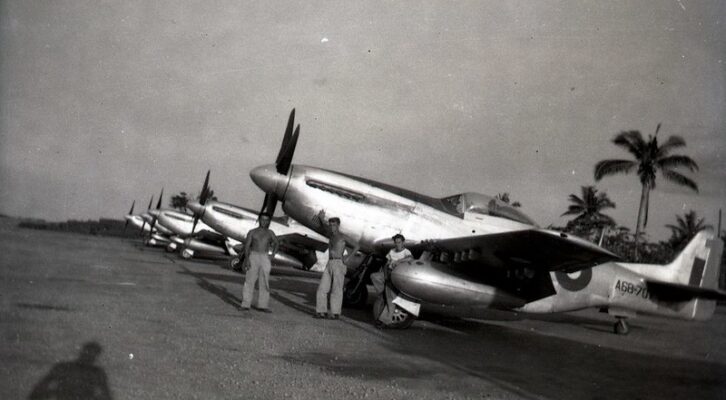
Putting the Asian Experience of World War II at Center Stage: A Reading List of Essential Books
Cundill Prize Finalist on Kazuo Ishiguro, Rana Mitter, Richard Flanagan, and More
Almost eight decades after the end of World War II, that conflict continues to define political discourse throughout the Western world. Still, for American, British, French, and Canadian readers, the war overwhelmingly means the European theater, with the Asia-Pacific campaigns against Imperial Japan as an afterthought. When they remember the Asian war at all, it’s mostly the Western experience there—the shock to the British of losing Singapore, or the bloody American campaigns for Iwo Jima and Okinawa. Present-day American public debates remain largely ill-informed about Asian politics and history.
Yet World War II should be understood as an interlocking global conflict spanning Asia. It was only with France and Holland defeated by Nazi Germany that Japan could march across the European empires in Southeast Asia and South Asia. While calling for freedom in Europe and the principles of the Atlantic Charter, the British Empire was controlling almost four hundred million people in India, Burma, Ceylon, and Malaya; the Dutch held more than seventy-five million Indonesians in what was then called the Netherlands East Indies. Some of what I’m trying to do in my new book, Judgment at Tokyo, is put the Asian experience of World War II at center stage.
As with anything written about World War II, this turn to Asia is part of a larger effort by a host of superb historians. Rana Mitter, Hans van de Ven, Chang Jui-te, Yang Tianshi, Tohmatsu Haruo, Edward Drea, the late Mark Peattie, and others have chronicled China’s desperate war with Japan. Frank Dikötter, Odd Arne Westad, Sarah C.M. Paine, Diana Lary, Daniel Kurtz-Phelan, and others are terrific on the Chinese Civil War. (I’m only covering books available in English, although my research used Japanese and Chinese sources in translation as well.) Max Hastings, John Toland, Richard Frank, Ian Toll, and others have written accomplished accounts of the military and strategic war in the Pacific. Srinath Raghavan and Yasmin Khan have done wonderful work about India’s role in the war, fielding some 2.5 million troops fighting not just in Burma and Singapore but as far away as the Middle East, North Africa, even Italy. Stephen Kotkin (in his magnificent multivolume biography of Stalin), Tsuyoshi Hasegawa, and Sean McMeekin have given fresh histories of Soviet decision-making. In an important recent contribution (which came out as I was finishing my book), Richard Overy in Blood and Ruins argues that the Axis powers were latecomers to imperial expansion who fought to displace the global order dominated by the British and French empires.
So I could have composed this reading list on World War II in a lot of ways. (For a reading list more closely related to the Tokyo war crimes tribunal itself, there’s excellent work by Yuma Totani, Onuma Yasuaki, Higurashi Yoshinobu, Ian Buruma, David Cohen, Barak Kushner, and more; the political theorist Judith Shklar in her brilliant book Legalism; political scientists debating about international justice ranging from Kathryn Sikkink to Jack Snyder; and international lawyers on the same topic such as John Witt, Oona Hathaway, and Jack Goldsmith.) I’ve chosen a couple of great books that especially fortified me throughout ten years writing the manuscript, which stand out for their work with primary sources, their nuance and fair-mindedness in analysis, and their deep knowledge of the Asia-Pacific.
*
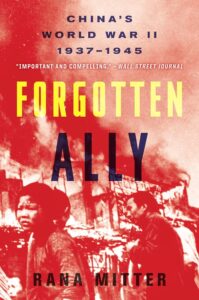
Rana Mitter, Forgotten Ally: China’s World War II, 1937-1945
In this masterful book, Rana Mitter restores China to a central place in World War II. China was at war for a full decade before Pearl Harbor, starting with the Japanese assault on Manchuria in September 1931, followed by a full-scale invasion starting in July 1937. The impact is impossible to grasp: some 14 million Chinese people died, as many as 80 million people were displaced from their homes; the economy and society were devastated. As Mitter notes, Allied strategy relied on having the Republic of China holding down some 800,000 Japanese troops. His book gives renewed respect to the resistance of the Nationalists led by Chiang Kai-shek (Jiang Jieshi), and covers their intensifying conflict with the Communists under Mao Zedong, while also giving a richly textured portrait of the fascinating Wang Jingwei—a heroic revolutionary of the Republic of China who in 1938 formed a pro-Japanese collaborationist government, for which he’s widely reviled in China today. Mitter shows how useful Chiang proved in working fellow anticolonialists in India. The book deftly explains a long and complicated war, while giving a ground-level narrative of what ordinary Chinese endured in such horrors as the conquest of Nanjing, the bombing of Chongqing, the flooding of the Yellow River, and the terrible famine in Henan province. It’s a powerhouse of a book, well worth your time.
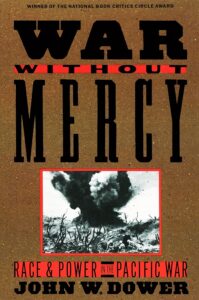
John W. Dower, War Without Mercy: Race and Power in the Pacific War
No list of books about the Pacific War could go without John Dower, the dean of historians about modern Japan. In thinking about the remaking of postwar Japan, I was—like everyone else—driven by his classic Embracing Defeat: Japan in the Wake of World War II, which remains the essential work on the occupation and the reconstruction of the country. Yet for understanding the war itself, this powerful book shows how racist hatreds drove the war between the United States and Japan. (Dower links the two books, arguing that what’s remarkable about the Allied occupation of defeated Japan is how quickly all that hate faded away.) War Without Mercy gives a searing account of how the Japanese were seen as subhuman: “monkeys, baboons, gorillas, dogs, mice and rats, vipers and rattlesnakes, cockroaches, vermin.” The most common trope to dehumanize the Japanese was calling them apes or monkeys. Sir Alexander Cadogan in the British Foreign Office wrote in his diary of the “beastly little monkeys,” while Admiral William Halsey raged against “yellow monkeys” and “monkeymen.” It is upsetting but essential reading.
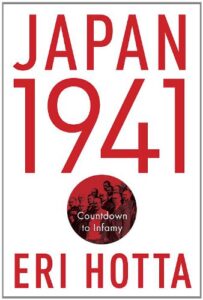
Eri Hotta, Japan 1941: Countdown to Infamy
Imperial Japan’s fatal decision to attack the United States and the British Empire, as well as the Dutch in the East Indies, ranks among the most perplexing and self-destructive in diplomatic history. Bogged down in the quagmire in China, why would they take on fresh wars against all that combined military-industrial might? How had the Japanese leadership believed simultaneously that the United States was so relentlessly aggressive that they had to attack it but also so submissive that it would slink to the bargaining table once struck? In this excellent book, Eri Hotta, who has also done outstanding work on Japanese pan-Asianism, shows how Imperial Japan’s rulers talked themselves into a catastrophic war. While unsparing in her assessment that the war was a reckless disaster, she carefully and fair-mindedly weighs the complex deeds of individual leaders such as General Tojo Hideki, Prince Konoe Fumimaro, Admiral Nagano Osami, and the peace-minded Togo Shigenori. Although Japanese right-wingers like to single out the Hull note in late November 1941, whose invocation is usually a dogwhistle for the claim that Pearl Harbor was really the United States’ own fault, Hotta’s expert account debunks that; she suggests that the United States toughened its terms in response to Japanese troop mobilization in the South Seas, indicating that Japan was ready to attack any day. Her book is rich in scholarship and nuance, with a penetrating understanding of Japan’s history. And even though you know how it’s going to end, the narrative is tautly suspenseful—you keep hoping they’ll back away from the abyss.
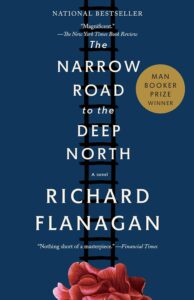
Richard Flanagan, The Narrow Road to the Deep North
I like historical novels and this is one of the best. It’s a love story and a story of loss, but set against the harrowing backdrop of the Burma-Thailand death railway. Imperial Japan ordered a railway built across Thailand through Burma, meant to open up a front against eastern India and to challenge China’s resupply through India. Although the Geneva Convention forbade using prisoners of war for the war effort, Tojo Hideki’s government used forced labor to build the railway under lethal conditions, especially Burmese and Malays, as well as Javanese, Tamils, Indians, Chinese, and more. The death railway is still a searing memory among Australians for their prisoners of war who suffered and died from beatings, abuse, amebic dysentery, malaria, dehydration, and more. (Flanagan has said that he was inspired by his father’s time as a prisoner of war on the railway.) Flanagan’s novel is about an Australian surgeon haunted by his time on the line, and his horrific descriptions are all too accurate. In a nod to this novel, my chapter on the abuse of prisoners of war is entitled “The Narrow Road to the Deep North”—itself an evocative title which Flanagan borrows from the classic travelogue by Basho, the seventeenth-century Japanese poet and diarist. In researching my book, I found many accounts that matched the most wrenching details in this novel, including a testimony of an Australian military doctor who on a typical day on the line would curette seventy or more reeking ulcers of the leg and amputate nine or ten legs. Flanagan writes powerfully about the strange comradeship among the Australians on the line: “But he had to help Tiny. No one asked why he did; everyone knew. He was a mate. Darky Gardiner loathed Tiny, thought him a fool and would do everything to keep him alive.”
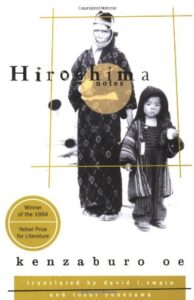
Kenzaburo Oe, Hiroshima Notes
Oe, who died in March, was one of Japan’s greatest modern writers, the winner of the Nobel Prize for literature in 1994. He was also one of Japan’s grand old pacifists—a fierce critic of the emperor system, an advocate for Japan’s pacifist constitution, dedicated to building a postwar country that would never repeat the horrors of militarism. When a young Oe wrote this nonfiction book, he was in personal agony: his first child had been born with a skull lesion, and he had to decide on an operation that would leave the boy permanently brain-damaged. (His son, although left impaired and almost blind, grew up to be a renowned composer.) In turmoil, Oe went to Hiroshima on numerous trips from 1963 to 1965 to report on efforts to abolish nuclear weapons, interviewing hibakusha—survivors of the atomic bombing. His views about the war matured over the years, of course, but this remarkable book uses his literary skill to sketch Japanese political activism, call for nuclear disarmament, and amplify the voices of the elderly survivors. He spoke to hibakusha in hospitals and in their homes, arguing movingly that they “possess unique powers of observation and expression concerning what it means to be human.”
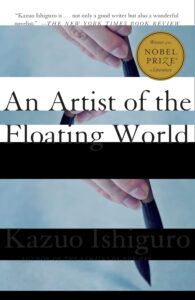
Kazuo Ishiguro, An Artist of the Floating World
This is another superb historical novel. Ishiguro, a British novelist who was born in Nagasaki, is probably best known for The Remains of the Day (1989), his Booker Prize-winning novel about a repressed English butler who dutifully served a lord who was a posh German sympathizer. Ishiguro deftly covers some of the same themes of professional self-delusion and the ambiguities of collaboration in this 1986 novel set in postwar Japan under American occupation. His narrator—an unreliable one—is an artist, and it gradually becomes clear that he was a prominent propagandist for the war. We learn that his son was killed in Manchuria in a senseless charge across a minefield. Yet the artist is unsettled by a younger generation that blames their elders for the war. He evades his own responsibility, even as his wartime conduct is undercutting the marriage prospects of his daughters in the radically changed postwar country. It’s a spare, lean, and chilling novel.
_____________________________
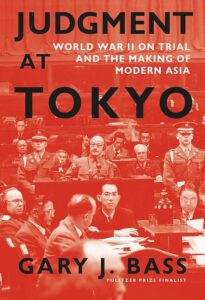
Judgment at Tokyo: World War II on Trial and the Making of Modern Asia by Gary J. Bass is available from Knopf.
Gary J. Bass
Gary J. Bass is a professor of politics and international affairs at Princeton University. He is the author of The Blood Telegram, a finalist for the Pulitzer Prize in general non-fiction, Freedom’s Battle: The Origins of Humanitarian Intervention, and Stay the Hand of Vengeance: The Politics of War Crimes Tribunals. A former reporter for The Economist, Bass has written for The New York Times, The New Yorker and The Washington Post amongst others. He holds a Ph.D. from Harvard University and lives in Princeton, New Jersey.



















